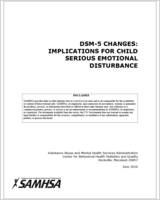All material appearing in this report is in the public domain and may be reproduced or copied without permission from SAMHSA. Citation of the source is appreciated. However, this publication may not be reproduced or distributed for a fee without the specific, written authorization of the Office of Communications, SAMHSA, HHS.
NCBI Bookshelf. A service of the National Library of Medicine, National Institutes of Health.
Structured Abstract
Background:
The Diagnostic and Statistical Manual of Mental Disorders (DSM), which was revised from DSM-IV to DSM-5 in 2013, provides the current criteria for measuring childhood mental health disorders. The Federal Register provides the definition of serious emotional disturbance (SED) based on DSM-III-R criteria. The purpose of this report is to describe the differences between the DSM-IV and DSM-5 diagnostic criteria that could affect national estimates of childhood SED, as defined in the Federal Register.
Method:
The report reviewed the wording and criteria related to childhood mental disorders under DSM-IV and DSM-5 and assessed the implications of the changes for generating estimates of SED and whether these revisions align with the Federal Register definition of SED. The report also described plans to integrate the DSM-5 changes into the leading diagnostic instruments for assessing childhood mental disorders.
Results:
The DSM-5 changes raise issues relevant to the definition of SED and which disorders are included in SED.
Conclusion:
Decisions will need to be made about which disorders within the new DSM-5 are included under the SED definition, and the disorders excluded from SED will need to be identified and explicitly stated. The DSM-5 changes will also narrow the number of diagnostic measures to be considered for use in children's mental health surveillance efforts until diagnostic instruments are updated to explicitly use DSM-5 diagnostic criteria.
Contents
Disclaimer
SAMHSA provides links to other Internet sites as a service to its users and is not responsible for the availability or content of these external sites. SAMHSA, its employees, and contractors do not endorse, warrant, or guarantee the products, services, or information described or offered at these other Internet sites. Any reference to a commercial product, process, or service is not an endorsement or recommendation by SAMHSA, its employees, or contractors. For documents available from this server, the U.S. Government does not warrant or assume any legal liability or responsibility for the accuracy, completeness, or usefulness of any information, apparatus, product, or process disclosed.
This publication may be downloaded from http://www.oas.samhsa.gov. Hard copies may be obtained from http://www.oas.samhsa.gov/copies.cfm. Or please call SAMHSA's Health Information Network at 1-877-SAMHSA-7 (1-877-726-4727) (English and Español).
Suggested Citation
Substance Abuse and Mental Health Services Administration. (2016). DSM-5 Changes: Implications for Child Serious Emotional Disturbance. CBHSQ Methodology Report. Center for Behavioral Health Statistics and Quality, Substance Abuse and Mental Health Services Administration, Rockville, MD.
The CBHSQ Methodology Report is prepared by the Center for Behavioral Health Statistics and Quality (CBHSQ), Substance Abuse and Mental Health Services Administration (SAMHSA), an agency within the U.S. Department of Health and Human Services that leads public health efforts to advance the behavioral health of the nation. SAMHSA's mission is to reduce the impact of substance abuse and mental illness on America's communities.
RTI Project No. 0212800.001.108.008.008.
Prepared by RTI International, Research Triangle Park, North Carolina.
RTI International is a registered trademark and a trade name of Research Triangle Institute.
- NLM CatalogRelated NLM Catalog Entries
- Review Impact of the DSM-IV to DSM-5 Changes on the National Survey on Drug Use and Health[ 2016]Review Impact of the DSM-IV to DSM-5 Changes on the National Survey on Drug Use and HealthSubstance Abuse and Mental Health Services Administration. 2016 Jun
- The Great Smoky Mountains Study of Youth. Functional impairment and serious emotional disturbance.[Arch Gen Psychiatry. 1996]The Great Smoky Mountains Study of Youth. Functional impairment and serious emotional disturbance.Costello EJ, Angold A, Burns BJ, Erkanli A, Stangl DK, Tweed DL. Arch Gen Psychiatry. 1996 Dec; 53(12):1137-43.
- Review How do clinicians actually use the Diagnostic and Statistical Manual of Mental Disorders in clinical practice and why we need to know more.[J Nerv Ment Dis. 2014]Review How do clinicians actually use the Diagnostic and Statistical Manual of Mental Disorders in clinical practice and why we need to know more.First MB, Bhat V, Adler D, Dixon L, Goldman B, Koh S, Levine B, Oslin D, Siris S. J Nerv Ment Dis. 2014 Dec; 202(12):841-4.
- Dimensional approaches to psychiatric diagnosis in DSM-5.[J Ment Health Policy Econ. 2011]Dimensional approaches to psychiatric diagnosis in DSM-5.Narrow WE, Kuhl EA. J Ment Health Policy Econ. 2011 Dec; 14(4):197-200.
- Review Adolescents and substance-related disorders: research agenda to guide decisions on Diagnostic and Statistical Manual of Mental Disorders, fifth edition (DSM-V).[Addiction. 2006]Review Adolescents and substance-related disorders: research agenda to guide decisions on Diagnostic and Statistical Manual of Mental Disorders, fifth edition (DSM-V).Crowley TJ. Addiction. 2006 Sep; 101 Suppl 1:115-24.
- DSM-5 ChangesDSM-5 Changes
Your browsing activity is empty.
Activity recording is turned off.
See more...

